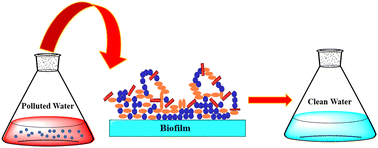Biofilm-mediated wastewater treatment: a comprehensive review
Abstract
Global industrialization has increased and so has the pollution generated by industries. Although all types of pollutions are a major concern for the environment, wastewater treatment has always intrigued the interest of researchers globally. Wastewater contains multiple contaminants, which can be treated via physical, biological, and chemical methods. Biological wastewater treatment technologies are seen as modern alternatives to conventional techniques that play a crucial role in improving human health and water quality. Organic pollution is one of the primary culprits of several phenomena, including eutrophication, decline in dissolved oxygen, and build-up of toxins, which impact the quality of water. Therefore, it becomes a necessity to eliminate organic pollutants from wastewater. The use of bioremediation as an environmentally benign method for the decontamination of harmful contaminants for environmental sustainability and safety has gained popularity due to the several disadvantages (expensive, operation, efficiency, and start-up) of traditional wastewater treatment plants. Bioremediation has been used to eliminate, mineralize, degrade, and neutralize many inorganic and organic contaminants from wastewater and contaminated environments using microbial communities (bacteria, fungi, and algae). The biofilm-mediated remediation method is one of the bioremediation techniques, which has been regarded as an economical and environment-friendly choice for environmental clean-up. Biofilms are aggregates of single or mixed microbial cells that adhere to a living or inert surface in an aqueous environment. In contrast to free-floating planktonic cells, biofilm-forming bacteria can compete for nutrients, show greater tolerance to contaminants, and offer a protective environment for cells. They show remarkable survival rate under extreme environmental parameters. Due to a properly regulated gene expression pattern mediated by quorum sensing, biofilm communities are therefore apt for the sorption and metabolism of organic contaminants and heavy metals. They are being used for wastewater treatment since the past few years due to their commendable ability to remove pollutants. Biodeterioration of materials such as metals, plastics, and concrete is accelerated by metabolic processes mediated by microorganisms living in biofilms. Electronic databases such as Scopus, Google Scholar, Science Direct, ACS, Wiley, Web of Science, Springer Link and, PubMed were used to collect all the appropriate information available in previously published literature related to biofilms. In this review, we briefly discuss the different types of biofilms used for wastewater treatment, factors affecting the development, structure, and function of biofilms and their use as potent biological remediation tools to accelerate the breakdown of environmental contaminants, types of bioreactors based on biofilms, and their application in removing various contaminants such as nitrate, bromate, and petroleum waste. In addition, the challenges faced while using biofilms in wastewater treatment and future perspectives have also been discussed.

- This article is part of the themed collection: Recent Review Articles


 Please wait while we load your content...
Please wait while we load your content...